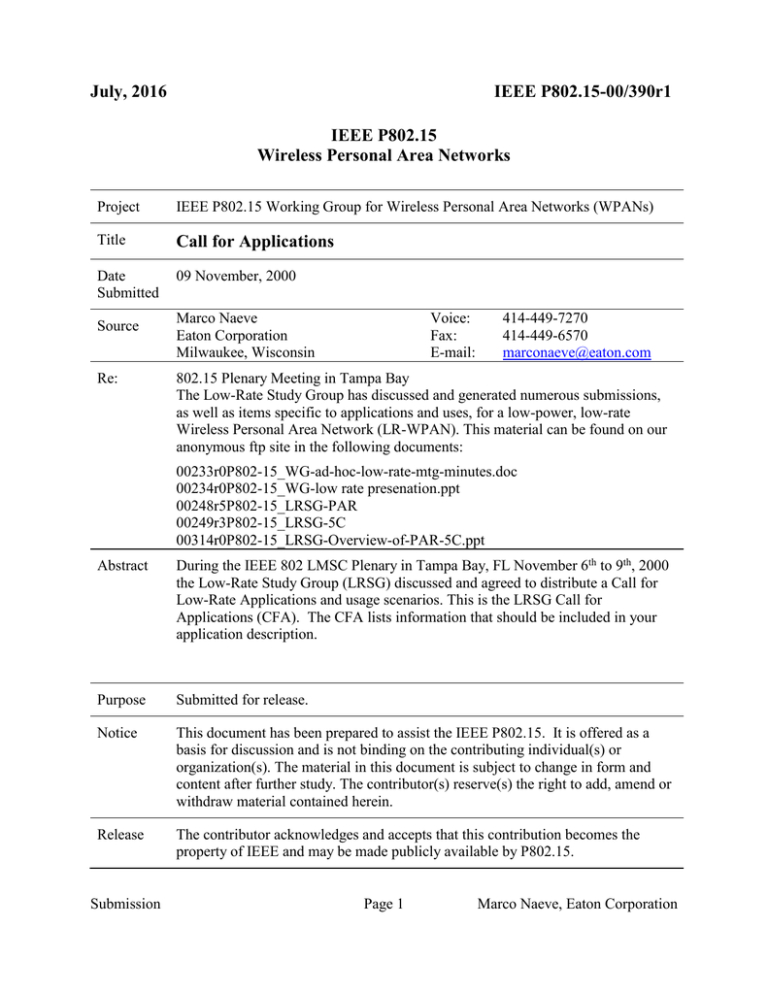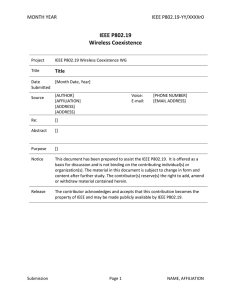July, 2016 IEEE P802.15-00/390r1 IEEE P802.15 Wireless Personal Area Networks
advertisement

July, 2016 IEEE P802.15-00/390r1 IEEE P802.15 Wireless Personal Area Networks Project IEEE P802.15 Working Group for Wireless Personal Area Networks (WPANs) Title Call for Applications Date Submitted 09 November, 2000 Source Marco Naeve Eaton Corporation Milwaukee, Wisconsin Re: 802.15 Plenary Meeting in Tampa Bay The Low-Rate Study Group has discussed and generated numerous submissions, as well as items specific to applications and uses, for a low-power, low-rate Wireless Personal Area Network (LR-WPAN). This material can be found on our anonymous ftp site in the following documents: Voice: Fax: E-mail: 414-449-7270 414-449-6570 marconaeve@eaton.com 00233r0P802-15_WG-ad-hoc-low-rate-mtg-minutes.doc 00234r0P802-15_WG-low rate presenation.ppt 00248r5P802-15_LRSG-PAR 00249r3P802-15_LRSG-5C 00314r0P802-15_LRSG-Overview-of-PAR-5C.ppt Abstract During the IEEE 802 LMSC Plenary in Tampa Bay, FL November 6th to 9th, 2000 the Low-Rate Study Group (LRSG) discussed and agreed to distribute a Call for Low-Rate Applications and usage scenarios. This is the LRSG Call for Applications (CFA). The CFA lists information that should be included in your application description. Purpose Submitted for release. Notice This document has been prepared to assist the IEEE P802.15. It is offered as a basis for discussion and is not binding on the contributing individual(s) or organization(s). The material in this document is subject to change in form and content after further study. The contributor(s) reserve(s) the right to add, amend or withdraw material contained herein. Release The contributor acknowledges and accepts that this contribution becomes the property of IEEE and may be made publicly available by P802.15. Submission Page 1 Marco Naeve, Eaton Corporation July, 2016 IEEE P802.15-00/390r1 [Original WPAN CFA document # IEEE 802.11_98/288] Please submit your application descriptions to the 802.15 Chairman, Bob Heile or the LRSG Vice-Chairman, Pat Kinney, by December 31st 2000, which is prior to the next IEEE 802.11 Interim Meeting. The IEEE 802.15 January meeting will be held during the week of January 15-19, 2000 at: Hyatt Regency Monterey On Del Monte Golf Course One Old Golf Course Road Monterey, CA 93940 Reservations: 408-831-1234 Reservation Fax: 9831-375-3960 Note: A LRSG Agenda will posted 30 days in advance of the meeting. Background The LR-WPAN project will define the PHY and MAC specifications for low data rate wireless connectivity for fixed, portable and moving devices with no battery or very limited battery consumption requirements typically operating in the Personal Operating Space (POS) of 10 meters. It is foreseen that a longer range at a lower data rate may be an acceptable trade-off. The project will develop a standard for ultra low complexity, ultra low cost, ultra low power consumption and low data rate wireless connectivity among inexpensive devices. The data rate will be high enough (maximum of 200kbps) to satisfy a set of simple needs such as interactive toys, but scaleable down to the needs of sensor and automation needs (10kbps or below) for wireless communications. The project may also address the location tracking capabilities required to support uses of smart tags and badges. Information to be Included in the Application Description In order to specify the physical (PHY) and medium access control (MAC) layers of the Low Rate Wireless Personal Area Network (LR-WPAN) it is necessary to give a detailed list of the network requirements. In order to completely specify the network requirements it is first necessary to describe the potential applications in detail. This dependency of the specifications is illustrated in Figure 1 where we see applications drive network requirements, which in turn drive the PHY and MAC layer specifications. Submission Page 2 Marco Naeve, Eaton Corporation July, 2016 IEEE P802.15-00/390r1 LR-WPAN Application Description LR-WPAN Requirements LR-WPAN PHY and MAC Specifications Figure 1: Illustration of specification dependencies This document is a call for LR-WPAN Application and Usage Scenarios. These scenarios need to be given in enough detail so that from a set of these descriptions we can completely specify the network requirements. The following is a list of some of the material that may be included in a description of your LR-WPAN application: 1. How many devices are in this low rate network? 2. What are the types of devices in that application (e.g. PDA, sensors, bar code scanner, etc.)? 3. Describe how the network is initiated. 4. How do devices attach and detach from the network. Is human intervention required? 5. Describe the traffic flow of the data. 6. Describe the type of data that flows in each branch of the network. 7. How much data is typically in each message? 8. How often are messages sent? 9. How much latency in the message transfer is acceptable? 10. Describe the network topology. 11. Is there a master node? Where do data flows originate and terminate? Are the devices peer to peer or master/slave? 12. Does this network have to interface to another network? If so, how should these two networks be connected? 13. If two low-rate networks are in range of one another, should they interact? If yes, how? 14. What is the type of data that would flow between two low rate networks? How often would they communicate? 15. How should these two low rate networks connect when they are within range? Should they configure themselves into one network or only communicate between master, for example? 16. Do the devices support authentication and security? 17. What is the data traffic type? (asynchronous) 18. What are the battery life requirements? 19. What is the physical size of the low-rate transceiver? 20. What is the range requirement of the application? 21. What is the estimate market size (units) of the proposed application? If anyone has additional application characteristics that they feel should be included in the list please add them. Submission Page 3 Marco Naeve, Eaton Corporation

